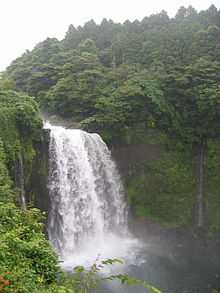Fujinomiya, Shizuoka
| Fujinomiya 富士宮市 | |||
|---|---|---|---|
| City | |||
 | |||
| |||
 | |||
 Fujinomiya | |||
| Coordinates: 35°13′N 138°37′E / 35.217°N 138.617°ECoordinates: 35°13′N 138°37′E / 35.217°N 138.617°E | |||
| Country | Japan | ||
| Region | Chūbu (Tōkai) | ||
| Prefecture | Shizuoka Prefecture | ||
| Government | |||
| • -Mayor | Naoyoshi Komuro | ||
| Area | |||
| • Total | 388.99 km2 (150.19 sq mi) | ||
| Population (June 2012) | |||
| • Total | 131,741 | ||
| • Density | 339/km2 (880/sq mi) | ||
| Time zone | Japan Standard Time (UTC+9) | ||
| - Tree | Maple | ||
| - Flower | Fujizakura | ||
| - Bird | Skylark | ||
| - Fish | Rainbow trout | ||
| Phone number | 0544-22-1119 | ||
| Address | 150 Yumizawachō, Fujinomiya-shi, Shizuoka-ken 418-8601 | ||
| Website | www.city.fujinomiya.shizuoka.jp | ||
Fujinomiya (富士宮市 Fujinomiya-shi) is a city located in central Shizuoka Prefecture, Japan.
As of June 2012, the city has an estimated population of 131,741 and a population density of 339 persons per km². The total area is 388.99 km².
Geography
Fujinomiya is located in central Shizuoka Prefecture on an upland plateau on the foothills and lower slopes of Mount Fuji with an altitude ranging from 35 meters to 3336 meters. The average temperature is 15.6 deg C. Much of the city lies within the borders of the Fuji-Hakone-Izu National Park. Fujinomiya is known as one of the basic starting points for climbing trips to Mount Fuji, the summit of which is partly within the borders of the city. As with most of Shizuoka Prefecture, the area enjoys a warm maritime climate with hot, humid summers and mild, cool winters.
Surrounding municipalities
- Shizuoka Prefecture
- Yamanashi Prefecture
History
Fujinomiya is an ancient settlement, developing as a market town associated with the Ichinomiya, or supreme Shinto shrine of Suruga Province, the Fujisan Hongū Sengen Taisha (富士山本宮浅間大社). It was also a post town (fortified during the Sengoku period) on the primary route connecting Suruga with Kai Province. During the Edo period the area was tenryō territory under direct control of the Tokugawa shogunate. British consul Sir Rutherford Alcock made the first recorded ascent on Mount Fuji by a non-Japanese from Fujinomiya in 1860. During the cadastral reform of the early Meiji period in 1889, the area was reorganized into Omiya Town and eight villages with Fuji District, Shizuoka.
The modern city was established on June 1, 1942 with the merger of Omiya Town with neighoring Fujioka Village. The city expanded by annexing neighboring Fujine village in 1955, and Kitayama, Shiraito, Kamiide and Ueno villages in 1956.
The most recent merger was on March 23, 2010, when the town of Shibakawa (from Fuji District) was merged into Fujinomiya.
Economy
Fujinomiya is an industrial center within Shizuoka Prefecture, traditionally with a heavy emphasis on the paper industry. Other manufacturing industries include rotating equipment, chemicals and pharmaceuticals.
Transportation
Highway
Rail
Bus
- Fuji Kyūkō
- Fuji-Kyū Shizuoka Bus
- Sankō town coach
- Fujinomiya Station - Tokyo International Airport Express Bus
- Fujinomiya Station - Tokyo Station Express Bus
- Kyoto/Osaka line Express Bus
Sister city relations
-
 Santa Monica, California, United States since July 21, 1975
Santa Monica, California, United States since July 21, 1975 -
 Shaoxing, Zhejiang Province, China, since November 11, 1997
Shaoxing, Zhejiang Province, China, since November 11, 1997
Local attractions
- Fujinomiya is famous for yakisoba noodles (富士宮やきそば Fujinomiya yakisoba)
- Mount Fuji
- Fujisan Hongū Sengen Taisha
- Shiraito Falls
- Asagiri Plateau
- Lake Tanuki
Festivals
- Hatsumōde (Fujisan Hongū Sengen Taisha)
- Yabusame (Horseback archery) Festival (May 4, 5, 6)
- Oyamabiraki (opening of climbing season) July 1
- Gojinka-festival (August)
- Fujinomiya Autumn Festival (November 3, 4, 5)
Events
- The 13th World Scout Jamboree was held August 2–10, 1971 on Asagiri Heights on the western side of Mount Fuji.
- The 9th ISF Women's World Championship was held in Fujinomiya, in 1998.
Noted people from Fujinomiya
- Kumiko Akiyoshi - actress
- Mizuki Sano - singer
- Kōtarō Satomi - actor
- Kaori Shimizu - singer
- Takahiro Yamada (Asian Kung-Fu Generation)
- Masaaki Sawanobori - professional soccer player
- Shinsuke Tayama - Olympic athlete
- Toshie Uematsu - professional wrestler
- Yasuhiro Hiraoka - professional soccer player
- Yutaka Yoshida - professional soccer player
- Hirotsugu Akaike - statistician
Gallery
-

Fujinomiya City
-

Climbing Mount Fuji-Fujinomiya routes
-

Shiraito Falls
-

Lake Tanuki
-

Asagiri Plateau
-
Otodome Falls
-
Wakutama Springs of Mount Fuji
-

Fujinomiya yakisoba
References
External links
- Fujinomiya official website
- Official Shizuoka Prefecture homepage
- FUJISAN HONGU SENGENTAISHA official website
- Mount Fuji Fujinomiya Trail Climbing Guide
- Mount Fuji Fujinomiya Trail Climbing Guide
- Fujinomiya info
| Wikimedia Commons has media related to Fujinomiya, Shizuoka. |
| ||||||||||||||||||||||||||||||||



